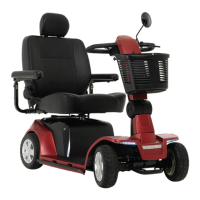
Do you have a question about the Pride MAXIMA and is the answer not in the manual?
| Drive System | Rear-wheel drive, sealed transaxle |
|---|---|
| Braking System | Electromagnetic |
| Wheel Size | 10 inches |
| Charger Type | Off-board, 5 amp |
| Charging Time | 8-14 hours |
| Ground Clearance | 3 inches |
| Overall Width | 25.5 inches |
| Motor | 24V DC |
| Battery Size | U1 |
| Battery Weight | 24.5 lbs each |
| Battery Type | Sealed Lead Acid |
| Seat Width | 18 inches |
| Seat Depth | 18 inches |
| Armrest Height | 9 inches |
| Tire Type | Solid |
| Colors Available | Red, Blue |
Welcome to Pride Mobility Products. Understand how to safely operate and care for your scooter. Read all instructions and warnings.
Agreement to not alter product. Check delivery for completeness and report issues.
Contact Pride Mobility Products with questions, comments, or suggestions. Notify of address changes.
Explanation of symbols used to identify warnings, mandatory actions, and prohibited actions in the manual.
Mandatory reading of manual, user responsibility, and professional guidance.
Pre-use inspections, weight limits, tyre inflation, and incline navigation for safe operation.
Guidelines for inclines, freewheel mode on inclines, and load limits for safe operation.
Tips for cornering, driving position, and understanding the braking system.
Safe use on different surfaces and how to approach obstacles like kerbs.
Precautions for inclement weather, freewheel mode, stairs, escalators, and doors.
Safety regarding lifts, lift products, battery handling, charging, and preventing unintended movement.
Safety during motor vehicle transport, getting on/off the scooter, and reaching/bending.
Precautions for medications, alcohol, smoking, and electromagnetic interference (EMI/RFI).
Description of the control console, housing key switch, speed dial, LED, throttle, and other controls.
Turn clockwise to power on, anticlockwise to power off. Adjust speed with the speed adjustment dial.
Alerts to electrical problems with flash codes. Use lights and turn indicators for visibility and signaling.
Controls forward and reverse speed. Lever returns to center 'stop' position, engaging brakes.
Indicates battery voltage strength using a color code (green, yellow, red).
Horn for warnings. Lights for visibility. Turn indicators and hazard lights for signaling.
Locates components like electronics module, batteries, circuit breaker, fuses, and freewheel lever.
How to engage/disengage freewheel mode. Warning: braking is disengaged in this mode.
Anti-tip wheels are a safety feature. Main circuit breaker protects system from overload/strain.
Assembly for use with lift systems, requiring specific inserts for lifting.
Scooter uses two 12V deep-cycle batteries. Keep them fully charged for optimal performance.
Use the battery condition meter on the control console to check battery voltage strength.
Follow safety rules: use correct outlet, ensure ventilation, inspect charger, keep away from children.
Step-by-step guide to safely charge scooter batteries. Answers common questions about charging.
Tips for maximizing range include full charging, proper tyre pressure, route planning, and steady speed.
Use AGM or Gel-Cell batteries. Handle with care, wear protective gear, and use identical batteries for replacement.
Detailed steps for removing and installing scooter batteries, including new battery break-in.
Keep batteries fully charged, avoid deep discharge, and consult dealer for public transport requirements.
Ensure batteries are charged and the freewheel lever is in the drive position before operating.
Follow safety steps, including key removal and proper positioning, to safely mount and dismount.
Verify seat/tiller adjustments, key status, horn function, and plan your route.
Maintain control with hands on tiller, feet on floorboard. Avoid distractions and ensure proper speed setting.
Bring scooter to a stop, remove key, rotate seat, and dismount safely. Understand the power down timer.
Adjust the tiller angle and seat rotation/position for optimal comfort and reach.
Adjust armrest width and height for personal comfort and ease of access.
Adjust the seatback angle and seat height for ergonomic support.
Use power seat only when stationary. Driving with seat elevated can cause instability and reduced speed.
Instructions for installing and adjusting the positioning belt for operator comfort and support.
Guide to disassembling the scooter into major components like seat, sections, shroud, and batteries.
Detailed steps for disassembly, emphasizing safe lifting and disconnecting harnesses before frame separation.
Steps for removing batteries, releasing locking mechanisms, and separating the scooter frame sections.
Detailed steps for reassembling the scooter, connecting sections, harnesses, and reinstalling components.
Explanation of status LED flash codes and their corresponding conditions and solutions.
Systematic checks for power issues: key, batteries, circuit breaker, connections, fuses, and timer.
Address motor not moving, circuit breaker trips, and battery meter dips or motor hesitation.
Maintain correct tyre pressure. Clean exterior surfaces; avoid conditioners on seat/floorboard.
Clean with damp cloth and mild cleanser. Follow disinfectant safety instructions carefully.
Check battery terminals, keep electronics dry, have motor brushes inspected by dealer.
Steps for replacing solid tyres, emphasizing safety precautions and proper installation.
Inspect wiring for damage, keep connections dry. Replace light bulbs and fuses with correct ratings.
Store scooter fully charged, disconnected, in a warm, dry place. Dispose according to regulations.
Details lifetime, 2-year, and 1-year limited warranties for frame, drivetrain, and electrical components.
Batteries covered for 12 months. Wear items and damage from misuse are excluded.
Detailed specifications for the Maxima scooter, including dimensions, weight, speed, range, and battery requirements.
Diagram illustrating the physical dimensions and turning radius of the Maxima scooter.